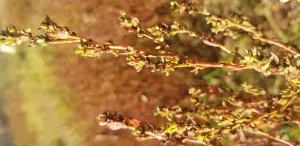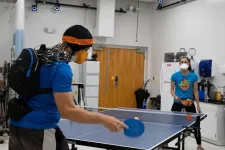(Press-News.org) COLUMBUS, Ohio – A new study’s finding that urban light pollution may disrupt the winter dormancy period for mosquitoes that transmit West Nile virus could be considered both good news and bad news.
The good news is that the disease-carrying pests may not survive the winter if their plans to fatten up are foiled. The bad news is their dormancy period, known as diapause, may simply be delayed – meaning they’re biting humans and animals longer into the fall.
“We see the highest levels of West Nile virus transmission in the late summer and early fall in Ohio. If you have mosquitoes postponing or delaying diapause and continuing to be active longer in the year, that’s at a time when the mosquitoes are most likely to be infected with West Nile virus and people could be at greatest risk of contracting it,” said Megan Meuti, senior author of the study and an assistant professor of entomology at The Ohio State University.
This study and earlier findings by Meuti and her colleagues are among the first to show that artificial light at night could have a significant impact on mosquito behavior – including effects that aren’t necessarily predictable.
“We’re finding that the same urban light at night can have very different effects under different seasonal contexts,” she said.
Meuti conducted the study with first author Matthew Wolkoff and Lydia Fyie, both PhD candidates in entomology at Ohio State. The research was published recently in the journal Insects.
Diapause for female Northern house mosquitoes (Culex pipiens) is not quite a winter slumber, but rather a period of dormancy when the insects live in caves, culverts, sheds and other semi-protected locations. Prior to winter’s arrival, mosquitoes convert sugary sources, such as plant nectar, into fat. As days get longer, females begin foraging for blood meals to enable egg production. Some get infected with West Nile virus by feeding on infected birds, and later transmit the virus when they feed on people, horses and other mammals.
This study builds upon two previous findings from Meuti’s lab: For her dissertation, Meuti found that circadian clock genes differ between diapausing and non-diapausing mosquitoes, strongly suggesting that day length dictates when diapause should start. And more recent work led by Fyie found that female mosquitoes exposed to dim light at night averted diapause and became reproductively active – even when short days indicated they should be dormant.
In the current study authored by Wolkoff, the researchers pursued both lines of inquiry, comparing daily activity and nutrient accumulation by mosquitoes reared in two lab conditions – long days mimicking the insects’ active season and short days that induced dormancy – with and without exposure to artificial light at night.
The study provided more evidence associated with a circadian pattern to mosquito behavior, showing that insects’ activity decreases during diapause, but the circadian rhythmicity of that activity is sustained even during this dormant period.
The introduction of artificial light at night was found to affect those activity patterns and to influence mosquitoes’ acquisition of nutrient reserves needed for fattening up and weathering winter temperatures.
Exposure to light pollution suppressed the amount of water-soluble carbohydrates – sugars that are an essential food source during winter – that were accumulated by mosquitoes in both long- and short-day conditions. Patterns of accumulation of the sugar glycogen were reversed by exposure to artificial light at night: Under normal conditions, non-dormant mosquitoes had lots of glycogen in their bodies but diapausing bugs did not – but in mosquitoes subjected to light pollution, the long-day mosquitoes didn’t accumulate much glycogen and short-day mosquitoes showed an increase in glycogen accumulation.
The researchers observed consistent trends in activity-related effects of light at night, with slight increased activity among the dormant mosquitoes and slightly suppressed activity among long-day mosquitoes expected to be busy looking for food. Though the findings weren’t statistically significant, Wolkoff said the combined observations suggest light pollution causes mosquitoes to ward off diapause – perhaps by scrambling signals from their circadian clock.
“This could be bad for mammals in the short term because mosquitoes are potentially biting us later in the season, but it could also be bad for mosquitoes in the long term because they might be failing to fully engage in preparatory activities they need to survive the winter during diapause, and that might reduce their survival rate,” Wolkoff said.
The researchers plan to carry out field studies to see if these lab findings hold true in the wild.
This work was funded by the National Science Foundation, state and federal funds appropriated to Ohio State’s College of Food, Agricultural and Environmental Sciences, and the U.S. Department of Agriculture National Institute of Food and Agriculture.
#
Contacts:
Megan Meuti, Meuti.1@osu.edu
Matthew Wolkoff, Wolkoff.13@buckeyemail.osu.edu
Written by Emily Caldwell, Caldwell.151@osu.edu; 614-292-8152
END
Xingpeng Li, an assistant professor in the Department of Electrical and Computer Engineering at the University of Houston’s Cullen College of Engineering, has been named an Emerging Leader by the 2023 Offshore Technology Conference. Of the nine honorees, Li is the only one from an institution of higher education.
The program selects young professionals with fewer than 10 years of experience in the offshore energy sector who demonstrate exceptional talents, commitment and promise as future leaders, according ...
The relationship between alcohol use and burn injuries is a negative one in multiple ways. Not only are about 50% of adults who sustain burn injuries intoxicated at the time of injury, suggesting that alcohol use may have contributed to the incident, but alcohol use among burn-injured patients is associated with more severe complications, delayed recovery, and increased morbidity and mortality.
“Return to work or normal life can be impaired or delayed for burn-injured patients who use alcohol,” says Elizabeth Kovacs, PhD, vice chair of research and professor of GI, trauma, and endocrine surgery ...
People who avoid COVID-19 precautions to prevent illness are more likely to purchase firearms – a pattern of behavior most common among moderate and conservative individuals, according to a Rutgers study.
The researchers surveyed a sample of 6,404 adults from three states: Minnesota, Mississippi and New Jersey. The survey was conducted in early 2021, before COVID-19 vaccines were widespread, and participants were asked about their intent to receive a COVID-19 vaccine, how often they wear masks in public, ...
For the last six years, Indiana University researchers and collaborators from around the world have sought to answer important questions about the most basic laws of physics that govern our universe. Their experiment, the Majorana Demonstrator, has helped to push the horizons on research concerning one of the fundamental building blocks of the universe: neutrinos.
The experiment’s final report was published in Physical Review Letters in February.
Neutrinos – subatomic particles similar to an electron but that have no electric ...
Researchers at the University of São Paulo (USP) in Brazil are using artificial intelligence (AI) and Twitter, one of the world’s largest social media platforms, to try to create anxiety and depression prediction models that could in future provide signs of these disorders before clinical diagnosis.
The study is reported in an article published in the journal Language Resources and Evaluation.
Construction of a database, called SetembroBR, was the first step in the study. The name is a reference to Yellow September, an annual suicide awareness and prevention campaign, and also to the fact that ...
An interdisciplinary team of researchers at the University of Oklahoma has published a perspective article in the journal Proceedings of the National Academy of Sciences advocating for convergent research that integrates the fields of biogeography and behavioral ecology to more rapidly respond to challenges associated with climate change and biodiversity loss.
While news about climate change fills headlines, the crisis of biodiversity loss has gotten less attention. In their article, the authors contend that “identifying solutions that prevent large-scale extinction requires addressing critical questions about biodiversity dynamics that – ...
The American College of Cardiology will host the annual Advancing the Cardiovascular Care of the Oncology Patient course on April 14-16, 2023, in Washington, DC. The course is intended for all members of the interprofessional care team—including cardiologists, oncologists, pharmacists and nurses—and aims to equip the global cardio-oncology community with the tools they need to improve patient care.
Ana Barac, MD, PhD, FACC, and Bonnie Ky, MD, MSCE, FACC, will serve as co-directors for the course, which ...
PHILADELPHIA—Brain development does not occur uniformly across the brain, but follows a newly identified developmental sequence, according to a new Penn Medicine study. Brain regions that support cognitive, social, and emotional functions appear to remain malleable—or capable of changing, adapting, and remodeling—longer than other brain regions, rendering youth sensitive to socioeconomic environments through adolescence. The findings were published recently in Nature Neuroscience.
Researchers charted how developmental processes unfold across the human brain from the ages of 8 to 23 years old ...
The story of how ancient wolves came to claim a place near the campfire as humanity’s best friend is a familiar tale (even if scientists are still working out some of the specifics). In order to be domesticated, a wild animal must be tamable — capable of living in close proximity to people without exhibiting dangerous aggression or debilitating fear. Taming was the necessary first step in animal domestication, and it is widely known that some animals are easier to tame than others.
But did humans also favor certain wild plants for domestication because they were more easily “tamed”? Research from Washington University in St. ...
Captain of her high school tennis team and a four-year veteran of varsity tennis in college, Amanda Studnicki had been training for this moment for years.
All she had to do now was think small. Like ping pong small.
For weeks, Studnicki, a graduate student at the University of Florida, served and rallied against dozens of players on a table tennis court. Her opponents sported a science-fiction visage, a cap of electrodes streaming off their heads into a backpack as they played against either Studnicki or a ball-serving machine. That cyborg look was vital ...




